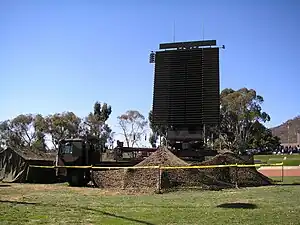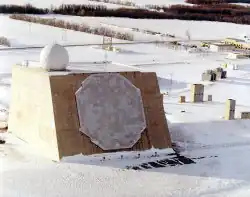
As defined by FS-1037C and ITU Radio Regulations, radiodetermination[1] is:
the determination of the position, velocity or other characteristics of an object, or the obtaining of information relating to these parameters, by means of the propagation properties of radio waves
There are two main fields to radiodetermination:[1]
- radionavigation: "used for the purposes of navigation, including obstruction warning", which is mainly active;
- radiolocation: "used for purposes other than those of radionavigation", which is mainly passive.
Examples
 Triangulation using radiodetermination
Triangulation using radiodetermination British Post Office mobile RDF, 1927
British Post Office mobile RDF, 1927 Direction-finding system Galeta Island
Direction-finding system Galeta Island Direction finder with direction-finding aerial
Direction finder with direction-finding aerial
International regulation
Radiodetermination service is – according to Article 1.40 of the International Telecommunication Union's (ITU) Radio Regulations (RR)[2] – defined as "A radiocommunication service for the purpose of radiodetermination."
Classification
This radiocommunication service is classified in accordance with ITU Radio Regulations (article 1) as follows:
Radiodetermination service (article 1.40)
- Radiodetermination-satellite service' (article 1.41)
- Radionavigation service (article 1.42)
- Radionavigation-satellite service (article 1.43)
- Maritime radionavigation service (article 1.444)
- Maritime radionavigation-satellite service (article 1.45)
- Aeronautical radionavigation service (article 1.46)
- Aeronautical radionavigation-satellite service (article 1.47)
- Radiolocation service (article 1.48)
- Radiolocation-satellite service (article 1.49)
Stations
A radiodetermination station is – according to article 1.86 of the International Telecommunication Union´s (ITU) ITU Radio Regulations (RR)[3] – defined as "A radio station in the radiodetermination service."
A radiodetermination station uses reception of radio waves in order to determine the location of an object, under the condition that this thing is reflecting and/or transmitting radio waves. This designation may also be the collective name of any radar set in general, up to target location, illuminating, acquisition and tracking, as well as radar sigh, altimeter and precision-guided munitions or bombs.
Each radiodetermination station shall be classified by the radiocommunication service in which it operates permanently or temporarily. In accordance with ITU Radio Regulations (article 1) this type of radio station might be classified as follows:
Radiodetermination station
- Radionavigation mobile station (article 1.87) of the radionavigation service (article 1.42)
- Radionavigation land station (article 1.88) of the radionavigation service
- Radiolocation mobile station (article 1.89) of the radiolocation service (article 1.48)
- Radiolocation land station (article 1.90) of the radiolocation service
- Radio direction-finding station (article 1.91)
- Selection radiodetermination stations
 A long-range radar (parabolic antenna)
A long-range radar (parabolic antenna) Air Traffic Control
Air Traffic Control mobile High finder radar
mobile High finder radar RAAF radar, AN/TPS-77
RAAF radar, AN/TPS-77
 Sea-mobile radar (Frigate Hamburg)
Sea-mobile radar (Frigate Hamburg) Air borne radar „Lichtenstein SN-2“ in the ME Bf 110G
Air borne radar „Lichtenstein SN-2“ in the ME Bf 110G Weapon homing radar
Weapon homing radar_aboard.jpg.webp) Sea-based x-band radar
Sea-based x-band radar Land radar (Fire control radar FuMG 39 „Würzburg“)
Land radar (Fire control radar FuMG 39 „Würzburg“)
See also
References
- 1 2 ITU Radio Regulations, Section IV. Radio Stations and Systems – Article 1.9, definition: radiodetermination
- ↑ ITU Radio Regulations, Section IV. Radio Stations and Systems – Article 1.40, definition: radiodetermination service
- ↑ ITU Radio Regulations, Section IV. Radio Stations and Systems – Article 1.86, definition: radiodetermination station
![]() This article incorporates public domain material from Federal Standard 1037C. General Services Administration. Archived from the original on 2022-01-22.
This article incorporates public domain material from Federal Standard 1037C. General Services Administration. Archived from the original on 2022-01-22.
Further reading
- "Chapter 4: Radiodetermination and Radiodetermination-Satellite Services". US Spectrum Requirements: Projections and Trends. 1993-12-31. Retrieved 2020-09-01.